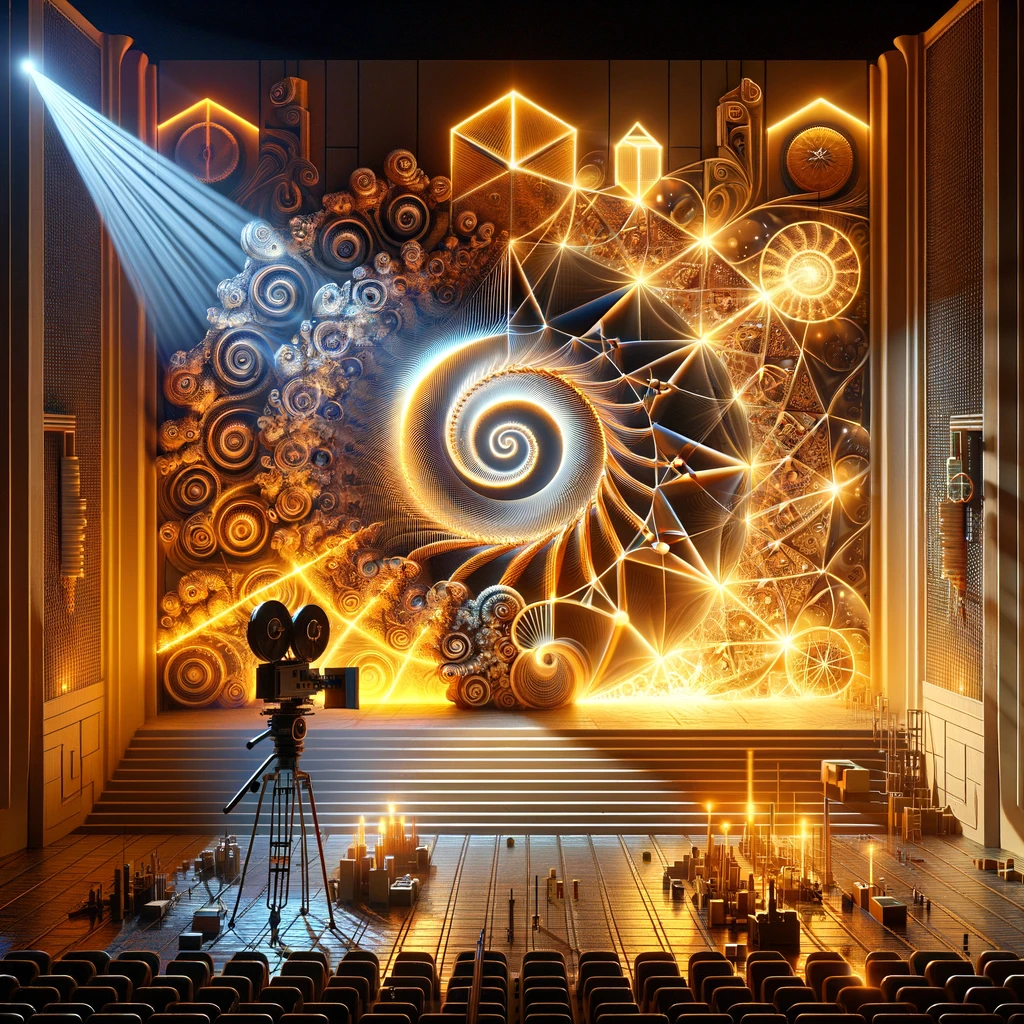Abstract
Films are meticulously crafted using visual aesthetic elements, where mathematics and geometry play pivotal roles. Camera angles, timing in editing, staging sequences, lens specifications, and lighting ratios, demonstrate the intricate relationship between cinema and mathematics. Specifically, the virtual projection of isosceles and equilateral triangles is utilized in object positioning before the camera. Additionally, forms such as circles, squares, and rectangles are frequently employed in stage design. Number combinations, sequential numbers, and patterns are also common techniques used to enhance visual aesthetics in films. Fundamental components such as oblique, horizontal, vertical, and parallel lines are instrumental in achieving visual appeal.
In our research, we investigate the properties of these components as they are discussed in scientific publications and their relevance to aesthetics. In this context, a comparative and quantitative analysis is conducted on 2001’s “Harry Potter and the Philosopher’s Stone” and the Turkish film “The Conquest 1453” (known as Fetih 1453 in Turkey). It is observed that “The Conquest 1453” employs excessive mathematical and geometric data, which somewhat diminishes the thematic strength of the film. In contrast, “Harry Potter and the Philosopher’s Stone” demonstrates a more balanced use of these elements.
References
Aksoy, F. (Director). (2012). Fetih 1453.
Ayteki̇n, H. (2011). Harry Potter ve Felsefe Taşı’nda Üslûp ve Mizah [Style and Humour in Harry Potter and Philosopher’s Stone]. Erciyes Üniversitesi Sosyal Bilimler Enstitüsü Dergisi, 1(30), 167-184. (In Turkish).
Bergman, I. (Director). (1963). The Silence.
Columbus, C. (Director). (2001). Harry Potter and the Philosopher’s Stone.
Dönmez, A. (Director). (2013). Taş Mektep [Stone School]. (In Turkish).
Elveren Ari, B., & Gürses Köse, İ. (2021). Metinlerarasılıktan Transmedya Hikaye Anlatıcılığına: Harry Potter [From Intertextuality to Transmedia Storytelling: Harry Potter]. Erciyes İletişim Dergisi, 2, 1–25. https://doi.org/10.17680/erciyesiletisim.954195 (In Turkish)
Feldt, L. (2016). Harry Potter and Contemporary Magic: Fantasy Literature, Popular Culture, and the Representation of Religion. Journal of Contemporary Religion, 31(1), 101–114. https://doi.org/10.1080/13537903.2016.1109877
Gülpinar, D. B. (2023). Writing History With Films: A Comparative Analysis of Films About the Conquest of İstanbul. Yedi, 29, 55–65. https://doi.org/10.17484/yedi.1089750
Huston, J. (Director). (1941). The Maltese Falcon.
Kara, Ş. (2007). Fantastik Çocuk Kitaplarında Uzamın İmgesel İşlevi ve Şiddet [Imaginary Function of Space and Violence in Children’s Fantastic Books]. Cankaya University Journal of Arts and Sciences, 1(7), 61-72. (In Turkish).
Kiliç, S. (2013). Sembolün Gücü Ve İslam’da Semboller [The Power of Symbol and Symbols in Islam]. Diyanet İlmi Dergi, 49(3), 7-20. (In Turkish).
Lang, W. (Director). (1954). There’s No Business Like Show Business.
Lynton, N. (2009). Modern Sanatın Öyküsü [The Story of Modern Art]. Remzi Yayınevi. (In Turkish).
Okumuş, M. S. (2020). 1974’ten 2020’ye TRT Tarih Dizileri [TRT History Series from 1974 to 2020]. Kocaeli Üniversitesi Sosyal Bilimler Dergisi, 1(39), 37–52. https://doi.org/10.35343/kosbed.738725 (In Turkish)
Orta, N. (2019). Toplumsal Bellek Ve Sİnema: Popüler Sİnema Örneğİ Olarak Fetİh 1453 [Social Memory and Cinema: Fetih 1453 as an Example of Popular Film]. Selçuk İletişim, 12(2), 1094–1126. https://doi.org/10.18094/josc.596314 (In Turkish)
Öztüfekci̇, T., & Di̇lmaç, S. (2021). Estetik Ve Modernizm: Modern Dönemin Estetik Algısı Ve Görsel Sanatlara Yansıması [Aesthetics and Modernism: Aesthetic Perception of the Modern Period and Its Reflection on Visual Arts]. STAR Sanat ve Tasarım Araştırmaları Dergisi, 2(3), 184-195. (In Turkish).
Şahi̇n, M., & Ugurlu, E. G. (2022). Türk Sinemasında Popüler Tarihi Filmlerde Türk Kimliğinin Yeniden İnşası. Karadeniz Teknik Üniversitesi İletişim Araştırmaları Dergisi, 12(1), 64–95. https://doi.org/10.53495/e-kiad.1094316 (In Turkish)
Sezgin, Y. (Director). (2012). Çanakkale 1915.
Sharma, S. (2023). The Triangle, Numeral 3, and the Trinity. Zagreb International Review of Economics and Business, 26(1), 197–222. https://doi.org/10.2478/zireb-2023-0010
Uzun, K., Karaman, A., & Akar, S. (Directors). (2013). Çanakkale Yolun Sonu.
Wyler, W. (Director). (1946). The Best Years of Our Life.
Wyler, W. (Director). (1959). Ben Hur.
Yavaş, B. (2022). Fantastik Sinema ve Mitolojinin Metinlerarası Aktarımı: Harry Potter ve Felsefe Taşı Örneği [Fantastic Cinema and the Intertextual Transfer of Mythology: The Case of Harry Potter and the Philosopher’s Stone]. Milel ve Nihal, 19(1), 79–103. https://doi.org/10.17131/milel.1099992 (In Turkish)
Yılmaz, M. (2014). Modernden Postmoderne Sanat [Art from Modern to Postmodern]. Ütopya Yayınları. (In Turkish).
Zemeckis, R. (Director). (2004). The Polar Express.

This work is licensed under a Creative Commons Attribution 4.0 International License.


